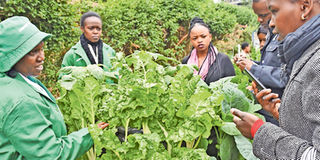Agronomist's notebook: Four common problems when farming spinach

Risper Chepkonga of Simlaw Seeds explains a point to farmers on how to grow spinach and other vegetables during a recent field day in Kiambu. The crop does well both in the open fields and greenhouses and a healthy plant should produce large dark-green leaves. FILE PHOTO | NMG
What you need to know:
- Nematodes make spinach wilt, creating brown yellow spots that are visible on the leaves. They feed on the roots, forming the galls.
- However, rotating spinach with another crop that does not belong to solanaceae family can help in controlling nematodes.
- To reap from spinach, use certified seeds that are resistant to diseases. Seeds are first sowed in the nursery, and transplanted after three to four weeks when they attain two to three true leaves.
- Watering should be adequately done throughout the growing season. Spacing varies depending on the variety, soil nutritional status, and the irrigation method.
Spinach is a common vegetable crop that is grown and consumed by many people. It is among the hardy crops that easily grow in a wide range of ecological zones.
It fetches high prices in the market and is rich in iron and calcium, among other nutrients. However, growing the crop comes with several challenges that make farmers harvest losses.
I visited a spinach farmer recently and one of the things I noticed about the crops on one block of his farm is that some were yellowing while others had white substances on the leaves.
On another block, the crops were wilting, and when I uprooted one, the plant had galls on the roots.
On farms where the drainage system is poor, water tends to accumulate in a specific location. This results in leaching of nutrients such as nitrogenous elements beyond the roots zone, leading to the yellowing of leaves.
This happens in cases where farmers top-dress without considering the drainage system.
To control this, especially during this rainy season, a farmer should have proper drainage on the farm, which can be achieved by creating channels that allow excess water to drain out. In soils such as black cotton, making raised beds encourages proper drainage.
The whitish substance I observed on the spinach leaves is caused by powdery mildew that makes the vegetables to taste bitterly.
This can be controlled by timely harvesting since the older leaves are mostly affected. Maintaining farm hygiene also helps in controlling fungal diseases and use of chemicals. However, the farmer must observe pre-harvest interval.
Nematodes make spinach wilt, creating brown yellow spots that are visible on the leaves. They feed on the roots, forming the galls.
Therefore, you should uproot the whole plant and burn it. This helps in reducing the nematodes population in the soil.
In some cases, it’s ideal to plant spinach in areas affected by the nematodes to control them.
CERTIFIED SEEDS ARE RESISTANT TO DISEASES
However, rotating spinach with another crop that does not belong to solanaceae family can help in controlling nematodes.
Spinach is also prone to caterpillars, which make rugged holes on the leaves. One should scout for the caterpillars on the lower and upper side of the leaves.
In small-scale farming, one of the simplest ways to control them is by picking and killing them.
The pests can also be biologically controlled by use of Bacillus thuringiensis products, spraying with pepper and use of neem oil. Other pests that affect the crop include snails and slugs.
To reap from spinach, use certified seeds that are resistant to diseases. Seeds are first sowed in the nursery, and transplanted after three to four weeks when they attain two to three true leaves.
The varieties planted in Kenya include Ford hook Giant and Swiss chard. Transplanting should be done early in the morning or late in the evening when the weather condition is calm to prevent shock.
Watering should be adequately done throughout the growing season. Spacing varies depending on the variety, soil nutritional status, and the irrigation method.
However, the ideal spacing between plants is 25 by 30cm. The crops grow well in well-drained fertile loamy soils with a pH of about 5-6.5.
It requires proper nutrition for growth, since it’s a heavy feeder, to offer a good harvest. Fertiliser application depends on the soil nutritional status.
A healthy plant should produce large dark-green leaves. The crop does well both in the open fields and greenhouses.
However, too much sun causes it to blot. Spinach matures 45 days after transplanting.
To harvest, cut the outer leaves to allow those at the centre to spread. With this and timely harvesting, you prevent bolting.
Under proper management, harvesting can be done every week for six months.
For more profit, plant spinach and sukuma wiki (collard greens) since a majority of consumers buy them together with spinach.





